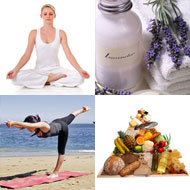- Aromatherapy (36)
- Benefits of Yoga (282)
- Home Remedies (1087)
- massage therapy (9)
- Preventive Therapy (135)
- Running (41)
- Skin Care (15)
- Stress Relief (25)
- Stretching (5)
- walking (33)
- Womens Health (14)
- Yoga Benefits for Pregnant Women (16)
- Yoga Benefits for Students (3)
- Yoga for Children (11)
- Yoga for Holistic Living (37)
- Yoga for Midlife Crisis (3)
- Yoga for Senior Citizens (2)
- Yoga for the Workplace (1)
- Yoga Health Tips (185)
- Yoga Practice during Menstruation (5)
Difference & Benefits of Bikram And Vinyasa Yoga

In the absence of a person’s age, gender and health status it is not very easy to answer this question. Going by general parameters though, it has generally been observed that Power Yoga, Vinyasa (Flow) Yoga and Bikram (Hot) Yoga are the most challenging. This is because they insist on putting their students through a rather rigorous and highly disciplined routine.
The Yogasanas (poses) in Power Yoga are specially designed to help trim down excess fat from the different parts of a person’s body. All the poses, particularly the forward bends, twists and backward bends help work out the areas around the hips, thighs and abdomen. In addition all the poses are performed after a couple of strenuous rounds of Surya Namaskar (Sun Salutation). Some of the asanas done in Power Yoga are Tadasana (Palm Tree Pose), Ardha Chakrasana (Half Wheel Pose), Pada Hastasana (Hands to feet pose), Bhujangasana (Cobra Pose) and Adho Mukha Svanasana (Downward Dog Pose). These are only a few, but the practitioners keep adding different poses to suit different needs.
Vinyasa (Flow) Yoga is something like a Tai Chi dance in slow motion, except that the practitioners use Yoga poses in sequences. It is just like the Surya Namaskar (Sun Salutation) in which a series of 12 – 14 Yoga poses are done dynamically one after the other without pausing or resting. In addition, they have added quite a few more asanas (poses) to help tone up and exercise different sets of muscles and internal organs. But, no matter what, all the asanas (poses) are done in a rapid sequence.
Hot Yoga, in which a set of 26 Yogasanas (poses) are practiced in a pre-heated room of up to 105 degrees Fahrenheit. Several Yoga professionals claim that this form of Hot Yoga has both therapeutic as well as cosmetic benefits.
Bikram (Hot) Yoga consists of 26 Yogasanas (poses) plus 2 Pranayama (breathing exercises). This discipline insists on every asana (yoga pose) being done twice in every ninety-minute session. These 26 poses are meant to stretch, tone up, limber and compress every single muscle group, every ligament and tendon, joint and organ in the practitioner’s body. This basically means that it is a wholesome and all encompassing approach that improves overall fitness levels and health.
These three are known to be the most challenging forms of Yoga. It’s hard to say that any one specific discipline is tougher or more demanding than the other as some may be more demanding in one particular aspect while easier in another.
- RSS Feeds -
- All posts
- All comments
- Can You Substitute Cardio with Yoga? Yoga is a great fitness routine, but a lot of people who have recently starte...
- Bikram Yoga Training Places Step up to 'hot' YogaWhen Bikram Choudhury synthesized tradi...
- Bikram (Hot) Yoga : Pros and Cons Bikram yoga is yoga which is taught by authorized teachers from the Bikram Yo...
- Chest Pains after Bikram Yoga Bikram yoga is a collection of traditional yoga techniques and has acquired i...